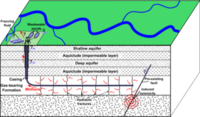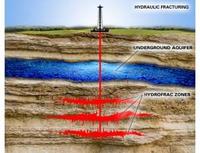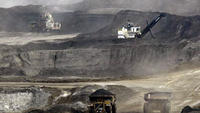-
Innovative hydroelectric solution harvests power from water flowing through municipal pipes
An innovative solution has made it so dams do not have to be built in order to get hydroelectricity; hydroelectric power can now be harvested from water flowing through municipal pipes; the innovation is creating energy by using existing infrastructure, as well as solving a problem in that infrastructure
-
-
Engineers develop electricity-free home cooling system
Researchers are developing a solar cooling and heating system for the home which will run independently of the electricity grid and generate domestic hot water as a by-product
-
-
Mystery of dramatic leveling off of methane in the atmosphere solved

Increased capture of natural gas from oil fields probably accounts for up to 70 percent of the dramatic leveling off seen in atmospheric methane at the end of the twentieth century; methane has twenty times the global warming potential of carbon dioxide, although CO2 is filling the atmosphere in far larger amounts
-
-
Engineering students build U.K. first hydrogen powered locomotive
Engineering students and staff at the University of Birmingham have designed and built a prototype hydrogen powered locomotive, the first of its kind to operate in the United Kingdom
-
-
Future increases in U.S. natural gas exports may not be as large as thought

Amid policy debate over potential liquefied natural gas (LNG) exports from the United States, a new study predicts the long-term volume of exports from the United States will not likely be very large; the paper also argues that the impact on U.S. domestic natural gas prices will not be large if exports are allowed by the U.S government
-
-
New process doubles production, slashes costs of butanol
Butanol has a 30 percent higher energy content than ethanol, lower vapor pressure, and is less volatile, less flammable, and mixes well with gasoline; a new discovery should make butanol more attractive to the biofuel industry
-
-
Farmers upset by plan for water banking system

Depending on the depth of the drilling, it can take anywhere from two gallons to two million gallons of water to frack one well; drilling companies consumeenough water in their fracking operations to meet the needs of between 66,400 and 118,000 households; in the parched Midwest, farmers raise questions about water-use priorities
-
-
Wind farms pose risks to ultra-light aircraft
Airfields for ultra-light aircraft are typically constructed on level ground — and so are wind farms; do wind power plants generate turbulence that could endanger lightweight planes? A simulation can compute how these power plants influence aircraft at various wind speeds and wind directions
-
-
Study finds correlation between injection wells and small earthquakes

Most earthquakes in the Barnett Shale region of North Texas occur within a few miles of one or more injection wells used to dispose of wastes associated with petroleum production such as hydraulic fracturing fluids, according to new research
-
-
Improving oil recovery, aiding environmental cleanup
Researchers have taken a new look at an old, but seldom-used technique developed by the petroleum industry to recover oil, and learned more about why it works, how it could be improved, and how it might be able to make a comeback not only in oil recovery but also environmental cleanup
-
-
A second look at off-shore use of vertical-axis wind turbines

Wind energy researchers are re-evaluating vertical axis wind turbines (VAWTs) to help solve some of the problems of generating energy from offshore breezes; though VAWTs have been around since the earliest days of wind energy research, VAWT architecture could transform offshore wind technology
-
-
Conflict of interests charges surround two pro-fracking studies

Two recent studies — by research institutes at the University of Buffalo and the University of Texas — on the relationship between fracking and the contamination of groundwater, offered what was claimed to be scientific, peer-reviewed research which concluded that fracking does not contribute to such contamination; an examination of the two reports reveals that they were not properly reviewed according to accepted academic standards, and that their authors, and the research institutes which sponsored them, are heavily involved with companies which conduct fracking operations; the author of the University of Texas report sits on the board of a leading fracking company, where his compensation is more than twice as large as his UT salary; he did not disclose this fact in the study — or inform UT of this connection; UT is investigating
-
-
Replacing coal with natural gas would reduce global warming
A new study finds that a gas substitution scenario, in which natural gas replaces all coal power production and any new oil-powered facilities by midcentury, would realize 40 percent of the reduction in global warming that could be achieved with a full switch to low-carbon fuel sources; this is a less costly, and more feasible, option, than switching all electricity generation immediately and aggressively to non-fossil fuel sources such as solar, wind, and nuclear
-
-
Emissions from oil sands-derived fuels too varied for uniform low-carbon standards

Policy makers need to be cautious in setting new low-carbon standards for greenhouse gas emissions for oil sands-derived fuels as well as fuels from conventional crude oils; researchers found that lifecycle greenhouse gas (GHG) emissions vary widely across both actual surface mining and in situ oil sands operations and conventional crude cases reported in the scientific literature, depending on individual project operating conditions, technology used, and other factors
-
-
Small, local energy technologies to help sustain vital services during blackouts
Researchers suggest that rethinking the solution to sustaining electric power — namely, starting small — could keep critical services going, even when the high-voltage grid is crippled; the U.S. military is already taking steps to protect its power supplies in the event of a massive grid failure by adopting small, local energy technologies, and California governor Jerry Brown recently announced that he wants 12,000 megawatts of such power supplies in his state
-
More headlines
The long view
Using Liquid Air for Grid-Scale Energy Storage
New research finds liquid air energy storage could be the lowest-cost option for ensuring a continuous power supply on a future grid dominated by carbon-free but intermittent sources of electricity.
Enhanced Geothermal Systems: A Promising Source of Round-the-Clock Energy
With its capacity to provide 24/7 power, many are warming up to the prospect of geothermal energy. Scientists are currently working to advance human-made reservoirs in Earth’s deep subsurface to stimulate the activity that exists within natural geothermal systems.
Experts Discuss Geothermal Potential
Geothermal energy harnesses the heat from within Earth—the term comes from the Greek words geo (earth) and therme (heat). It is an energy source that has the potential to power all our energy needs for billions of years.
